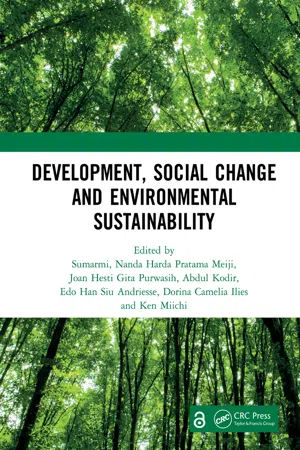
Development, Social Change and Environmental Sustainability
Proceedings of the International Conference on Contemporary Sociology and Educational Transformation (ICCSET 2020), Malang, Indonesia, 23 September 2020
- 172 pages
- English
- ePUB (mobile friendly)
- Available on iOS & Android
Development, Social Change and Environmental Sustainability
Proceedings of the International Conference on Contemporary Sociology and Educational Transformation (ICCSET 2020), Malang, Indonesia, 23 September 2020
About This Book
Nowadays, the concept of SDGs (Sustainable Development Goals) is starting to replace the concept of MDGs (Millennium Developmental Goals). It is a global goal adopted by all United Nations member states. It emphasizes the idea that the development of every country can only be achieved by balancing other factors such as social, economic, and environmental sustainability. It is already clear how sustainable development works with environmental ethics and management. However, there are still issues regarding the sustainable development and human well-being. Sustainable development should focus on finding a way for society to meet their present needs for the long term without sacrificing the ability of future generations to meet their needs. This international seminar provides research results and literature regarding the topic of sustainable development concept, the dynamics of sustainable development and social change, and environmental sustainability. The international seminar, entitled 1 st International Conference on Contemporary Sociology and Educational Transformation, listed speakers from several countries providing an overview on human and environmental resilience. This book contains a selection of papers presented at the conference.
Frequently asked questions
Information
Utilization of new media as a promotion facility in entrepreneurship development for students at SMAN 1 Torjun
1 Introduction
2 Method
2.1 Training entrepreneurship, which is applied through the methods
- Lecture: conducted to deliver materials about entrepreneurship and local potential in Torjun, Sampang Regency.
- Question and answer: conducted to answer or resolve problems faced by participants related to entrepreneurship material, entrepreneurial motivation and local potential of Torjun, Sampang Regency
- Discussion: through this discussion forum, students are expected to gain reinforcement and confidence related to entrepreneurship, entrepreneurial motivation and local potential of Tojun, Sampang Regency.
2.2 Information technology and “new media” awareness training for students of SMAN 1 Torjun, which is applied through the method
- Demonstration: conducted to convey material about its importance in information technology and “new media” to support entrepreneurship for students of SMAN 1 Torjun.
- Question and answer: conducted to answer or solve the problems faced by the participants related to information technology and “new media” as a means of supporting entrepreneurship for students of SMAN 1 Torjun
- Assignment: through this assignment, students are expected to gain increased knowledge and skills of information technology and “new media” to support entrepreneurship for students of SMAN 1 Torjun
3 Results and Discussion
3.1 Uneducated and lack of motivation regarding entrepreneurship
3.2 Figure captions lacking in knowledge and skills of students regarding technology and “new media” as a means of supporting entrepreneurship
Table of contents
- Cover
- Half Title
- Title Page
- Copyright Page
- Contents
- Preface
- Acknowledgments
- Organizing committee
- Scientific committee
- The effect of the Problem Based Service Eco Learning (PBSEcoL) model on student environmental concern attitudes
- Community conservation in transition
- Sociology and geography of growing seaweed in the Philippines
- History of the Ludruk Rukun Famili in Sumenep Madura Island, 1943–1997
- Promoting moderatism, countering radicalism: Religious discourse of high school students in Malang
- The female terrorism: Victimization in the striving for family
- Legal culture in cockfighting games in east Java communities, Indonesia
- “Sumberawan water site”: History, sustainable preservation and use as a learning source
- Coping strategy based on socio-agriculture approach in Landslide Prone Area in the Gede Catchment, Malang Regency
- Utilization of new media as a promotion facility in entrepreneurship development for students at SMAN 1 Torjun
- Plague in Malang 1910–1916
- The problems of COVID-19 waste management in East Java
- The dynamics of community response to the development of the New Capital (IKN) of Indonesia
- Geo-ecological interaction: Community based forest management in Karanganyar, Indonesia
- The development of application for child care services in facilitating distance learning
- Educators’ professional ability to manage online learning during the COVID-19 pandemic
- Learning style from face-to-face to online learning in pandemic COVID-19 (the case study at East Java)
- Private school reform through learning community: Evidence from Muhammadiyah School
- Women in education: A review of Indonesian feminism
- The woman’s international migration: Controlling rural land by women workers
- Analysis of population vulnerability towards the spread of COVID-19 in Malang Raya from a spatial perspective
- The distribution problem of social safety net program in Surabaya and Gresik during pandemic
- Capturing the dual role of female medical workers during the COVID-19 pandemic in Surabaya
- Environmental health behavior of fishing communities during COVID-19 pandemic
- Social media management as optimization of tourism potential in Osing Kemiren, Banyuwangi Regency
- From pandemic to infodemic: Bias information of covid-19 and ethical consideration among Indonesian youtuber
- How virtual fancy things build self-presentation? consumer’s acceptance and use of e-commerce
- Assessing the role of mass media in information mitigation on COVID-19 pandemic issues in Indonesia: A discourse analysis on KOMPAS daily newspaper
- The levels of empowerment of forest farmer group in coastal village development in South Malang, Indonesian
- Digital activism through online petition: A challenge for digital public sphere in Indonesia
- Philanthropy movement’s response to government policy in negotiating COVID-19 in Indonesia
- Facilitating communities to identify local potential and hazards through P-GIS and FGD
- Optimizing village assets for rural tourism development in South Malang
- Zoo management for animal welfare through sustainable tourism principles
- Development strategy sustainability of historical and cultural tourism in Pacitan
- Author index